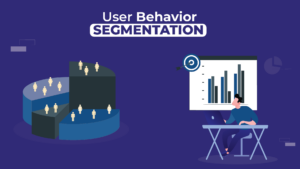
Customer Lifecycle Vs Customer Journey – What’s The Differences
Customer Lifecycle Is a Complete Cycle of the Customer with the Business whereas Customer Journey focuses on specific paths or interactions. Assume a customer lifecycle

Curious to know how to measure product market fit? According to Marc Andressen: “Product market fit refers is being in a good market with a product that can satisfy that market.”
It’s a transient situation in which your product provides your clients with the ideal solution to a significant enough problem. You’ll experience exponential organic growth fueled by word of mouth after you find Product Market Fit.
Not all products have a clearly built path to the product-market fit. Understanding your current position on the path to the holy grail of product-market fit is not so simple. How can you tell if your efforts are yielding positive results?
Today, I’ll discuss a couple of methods for determining product-market fit and how you can quickly and effectively gauge your progress in that direction.
After you achieve product-market fit, your job will become much simpler because customers and other interested parties will be heavily involved in your marketing efforts.
They might even talk about their own experiences with others so that you can focus on ensuring that everyone who engages with your company has a great time.
The market for any given product is restricted. Therefore, identifying potential customers for your SaaS approach includes both those who might try your product and those who might end up being devoted subscribers.
You can estimate product-market fit by knowing not only who your potential market is but also how big that market is. The total addressable market (TAM). Moreover, you may gauge the size of the market you are targeting (and its potential revenue) using the total addressable market measure.
The percentage of your TAM that our clients can be ascertained once you have identified your TAM. The percentage of TAM you serve will potentially rise over time as you approach achieving product-market fit.
While it may be discouraging to learn that not every person with an Internet connection will need your widget, attempting to please everyone at once will only lead to failure.
Instead, you may invest in features and enhancements that they enjoy and so attract more customers who share those first fans’ interests by focusing even more on the customers who actually love your product.
When it comes to a SaaS company that depends on recurring revenue and satisfied customers to stay afloat and expand, becoming a crucial resource for millions of people is actually a better conclusion than being a take-it-or-leave-it choice for billions.
Once you have an understanding of your target market and its size, you must then apply reality to the circumstance. You won’t get 100% of your TAM, even though it is X, to buy your goods. Therefore, you should decide how much of that market you can really hope to grab.
It’s crucial to initially focus on the Serviceable Addressable/Addressable Market (SAM), which is what is within your geographical reach, before determining the Serviceable Obtainable Market because TAM is valuable but totally theoretical in terms of what you will actually capture (SOM).
Your SOM, often known as “how much of the pie” you’ll actually get, is the portion of the SAM that you can actually achieve.
Product initiatives and product ideas are other names for product hypotheses. In order to separate my prejudices from the product idea, I like to refer to them as hypotheses.
Take a look at your internal and external data channels to generate product hypotheses. Speak with customers, examine product statistics, research competitor companies, and consult internal teams.
Invite the key players on your product team the tech lead, a designer, a decision-maker, and a subject matter expert to a meeting to discuss priorities. Keep the meeting to discuss preferences brief. The ideal squad size is between 4 and 5.
Go through the list of product hypotheses and assign an expected impact, confidence level, and effort to each hypothesis.
Get input on the product hypotheses from five customers before you begin building. You should be able to tell whether the idea is worthwhile to pursue after five clients.
Utilize both qualitative and quantitative customer data to understand the relationship between what people say and what they actually do. From a few days to a few weeks, this process may take. Three eventualities are to be anticipated:
It’s time to go to the following phase assuming that customers are providing you with positive comments.
There is no single North Star measure for determining product-market fit. Instead, several metrics are taken into account along the way. None of these indicators are connected to a magic number.
You may be confident that you’re well on your path to establishing product-market fit when you notice regular improvement and success in all of the aforementioned areas. Moreover, you may want to think about measuring the following things,
Let’s look at some well-known cases to properly put the concept of product-market fit into perspective: one where the business successfully executed its products and services while fully grasping its market and value proposition, and the other where it fell short.
Uber was established in 2009 as a cutting-edge ride-sharing business by Travis Kalanick and Garrett Camp.
It is currently active in 72 nations and more than 10,000 cities worldwide. Since then, Uber has increased the scope of its services to include food delivery, couriers, package delivery, electric scooters, and bicycles, among other things.
Currently, the corporation is valued at around $42 billion. Uber discovered a genuine need that no other company had effectively addressed by being very explicit about who its target market was.
Initially, professionals in American cities were the target market; however, it has already expanded significantly beyond this. Despite how unbelievable it may sound now, in the late 2000s it was frequently difficult and time-consuming to locate a taxi.
Uber currently has 93 million users, and in 2020 alone, the organization recorded 4.98 billion rides.
Product-market fit rarely occurs on the first attempt. Before you find the ideal balance of value proposition, customer base, and distribution, you’ll probably test and modify your product or service a number of times.
Try new things frequently depending on audience response, modify your concept if the data suggests it, and be ready to change course if required.
When music-sharing service Napster shut down in 2001 after accusations of copyright infringement, Daniel Ek, CEO of Spotify, realized that many of the components for product-market fit were already in place.
The music was already available, it could be distributed via mobile devices, and Napster had a substantial user base. Spotify had faith that this market of people may be willing to pay a little amount for a platform that offered free legal access to music.
The popularity of Spotify increased tremendously among the youthful market as technology advanced and the company grew to use sophisticated online content crawlers and natural language processing technology.
Since by 2022, Spotify had accrued 182 million paid customers, illustrating the success that can be attained by identifying a market need and a product that is worthwhile investing in.
Coca-Cola is one of the best-selling soft drinks in the world, but Pepsi-Cola, its primary competitor, was gaining market share in the late 1970s and early 1980s, and consumer surveys indicated that consumers preferred the sweeter flavor of their main competitor’s product.
With more than 190,000 blind taste testing completed and consumer research data at hand, Coca-Cola debuted New Coke in 1985 to take against Pepsi and completely discontinued its previous formula.
Consumers’ emotional ties to the original Coca-Cola beverage were underestimated by researchers, who neglected to inquire about their reactions should the product itself disappear (recall the 40 percent rule).
At the height of the uproar, Coca-Cola was receiving 8,000 irate complaints every day from loyal customers who were upset.
Your job will get a lot easier after you achieve product-market fit since your consumers and other interested parties will play a big role in your marketing campaign.
They may even share their own experiences with others so you can concentrate on making sure everyone who interacts with your business has a wonderful time.

Customer Lifecycle Is a Complete Cycle of the Customer with the Business whereas Customer Journey focuses on specific paths or interactions. Assume a customer lifecycle

Welcome to the world of user activation software, where the secret sauce to unlocking the full potential of your product or service lies. In this
Have you ever wondered how businesses track user actions on their websites or apps? How do they measure the success of their marketing campaigns and

Have you ever wondered how users navigate through websites or apps? How do they seamlessly move from one screen to another, making decisions and accomplishing

Do you want to create a product that truly speaks to your customers? Are you looking for ways to gather valuable feedback and improve the

Ever wondered how often customers visit your online store before making a purchase? Or which promotional messages drive higher-value sales? User behavior segmentation holds the
Join companies that have successfully reduced their churn rate by up to 40% using StatWide’s predictive analytics.